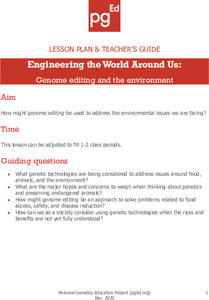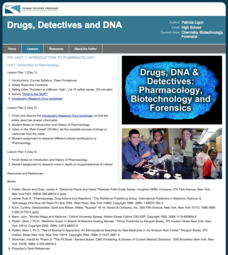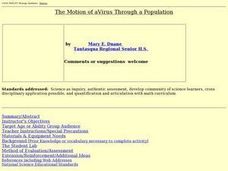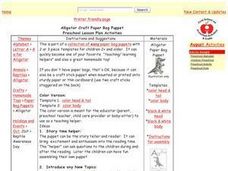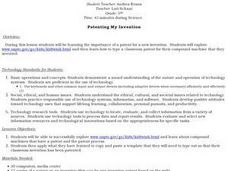Curated OER
Lab Safety
In this safety worksheet, students read about lab safety including safety equipment and procedures. Students learn about reading chemical labels and the MSDS. This worksheet has 14 matching and 13 short answer questions.
Curated OER
The Price of Beauty: What you don't know might hurt you
Young scholars study cosmetic safety issues and concerns raised by advocacy groups. They create a cosmetic safety brochure designed for the average consumer, to create awareness about cosmetic safety concerns.
Curated OER
Escape! Because Accidents Happen-Fire
Students view a video clip about fire safety. They work together to research fire safety strategies in public and private buildings. They create a prototype of a building using safety measures.
Curated OER
The Dirt on the Workplace
Students examine health and safety issues in the workplace. They, in groups, discuss how health and safety issues effect their lives.
Curated OER
Double Trouble?
Students investigate cloned meat and animal products. In this food safety instructional activity, students research the noted Web sites in search of information about cloning and food labelling. Students use their findings to create...
Personal Genetics Education Project
Engineering the World Around Us: Genome Editing and the Environment
Challenge young minds to build a better world with genetic engineering. Biologists learn potential solutions for environmental issues using genome editing while interacting with three case studies. Scholars read articles and view...
Curated OER
Make A Plan
In this science worksheet, learners create a plan on what product they will test. They describe what they want to discover about this product and write questions that address the goal of their experiment. Finally, students determine what...
Curated OER
Machine Guarding
Twelfth graders describe at least two of the main causes of machine accidents. Possible responses: Unauthorized persons doing maintenance or using the machines. Missing or loose machine guards. List three of the requirements for...
Curated OER
Heavy Issues
Fourth graders compare the difference between the mass of people, vehicles and trains in order to explain why it is important not to trespass on railroad tracks.
Kenan Fellows
Unit 1: Introduction to Pharmacology
Learn about the study of medications, including those found in nature and those made synthetically. The first of four lessons in a series on pharmacology includes lectures, hands-on experiments, research, and more.
Mascil Project
Water Quality
How do you prevent the spread of water-borne illness in large public swimming areas? Scholars discover the challenges to identifying safe water through an inquiry experiment. They then produce posters sharing their understanding of water...
Curated OER
Take a Stab!
Your geology class practices taking core samples of a potato to examine the stratigraphy. This is a terrific modeling activity that helps youngsters visualize strata that cannot be seen from the surface of the ground. The directions...
Curated OER
The Power of Atmospheric Pressure Process
Students are introduced to the basic principles of atmospheric pressure. After watching demonstrations, they discover the capability of air pressure and how it affects weather. In groups, they use an inquiry template to solve different...
Curated OER
The Motion of a Virus Through a Population
Students test the factors that influence the rate at which a virus spreads through a population. They complete a lab activity then discuss data collected and review and answer a set of questions.
Personal Genetics Education Project
DNA, Crime and Law Enforcement
Civil rights meets biotechnology in a instructional activity that scrutinizes the collection of DNA of citizens who have been arrested, but not yet convicted of a crime. Real-life cases are examined in which the DNA of a relative was...
Cornell University
Atomic Bonding
Explore the connection of surface area to bonding within atoms. Learners complete lab investigations to model changing surface area with different sizes and concentrations of atoms. A flour fireball demonstration follows the labs to...
Curated OER
Contraceptives: Which Work Best?
Learners discover human health by identifying contraceptive methods. In this sexual health lesson, students discuss the different methods used to prevent births and STD contraction. Learners read assigned text which describes each method...
Curated OER
Magnetic Discovery Bottle
Students examine how to conduct simple investigations and use simple equipment to gather data. In this magnet lesson plan students decide what types of objects are attracted to magnets.
Curated OER
Alligator Craft Paper Bag Puppet
Students make paper bag puppets. They use the puppets as a story teller and reader. Students use the puppets to ask questions during and after reading. They assemble their own puppet. Students use the puppets to introduce new themes,...
Curated OER
Castaway or Survivor
What a clever idea! Chemistry learners imagine themselves deserted on an island with a radio, but no batteries. They also have a few odds and ends in their pockets and storage chest. They are challenged to create a battery that will...
Curated OER
Waste Management
Four different activities focus on the amount of trash generated and how humans can better manage waste. Learners analyze two days' worth of household garbage, test materials for biodegradability, and rate recyclability of various...
Curated OER
Patenting My Invention
Fifth graders learn the importance of a patent for a new invention. They use the internet to practice typing a classroom patent for a compound machine that their class invented. While on the website, 5th graders choose a month and...
Curated OER
Heat Pollution and Communities
Learners examine thermal pollution by collecting temperature data on the school's photovoltaic panel. Students collect data for four consecutive days and retrieve information from other classes that meet at different times of the day. ...
Curated OER
Waste Management
Students investigate the amount of trash they generate, the problems that result and possible solutions.They complete four activities regarding household trash, biodegradability, packaging, and recycling.





